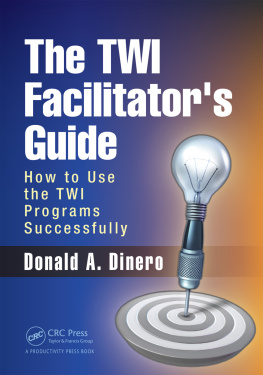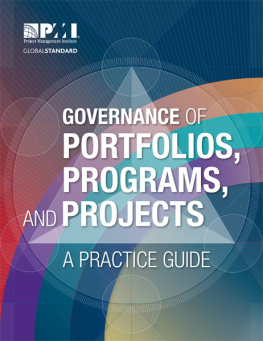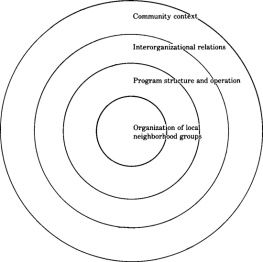Contents

The TWI Facilitators Guide
How to Use the TWI Programs Successfully
The TWI Facilitators Guide
How to Use the TWI Programs Successfully
Donald A. Dinero

CRC Press
Taylor & Francis Group
6000 Broken Sound Parkway NW, Suite 300
Boca Raton, FL 33487-2742
2017 by Donald A. Dinero
CRC Press is an imprint of Taylor & Francis Group, an Informa business
No claim to original U.S. Government works
Printed on acid-free paper
Version Date: 20160419
International Standard Book Number-13: 978-1-4987-5484-2 (Paperback)
This book contains information obtained from authentic and highly regarded sources. Reasonable efforts have been made to publish reliable data and information, but the author and publisher cannot assume responsibility for the validity of all materials or the consequences of their use. The authors and publishers have attempted to trace the copyright holders of all material reproduced in this publication and apologize to copyright holders if permission to publish in this form has not been obtained. If any copyright material has not been acknowledged please write and let us know so we may rectify in any future reprint.
Except as permitted under U.S. Copyright Law, no part of this book may be reprinted, reproduced, transmitted, or utilized in any form by any electronic, mechanical, or other means, now known or hereafter invented, including photocopying, microfilming, and recording, or in any information storage or retrieval system, without written permission from the publishers.
For permission to photocopy or use material electronically from this work, please access www.copyright.com (http://www.copyright.com/) or contact the Copyright Clearance Center, Inc. (CCC), 222 Rosewood Drive, Danvers, MA 01923, 978-750-8400. CCC is a not-for-profit organization that provides licenses and registration for a variety of users. For organizations that have been granted a photocopy license by the CCC, a separate system of payment has been arranged.
Trademark Notice: Product or corporate names may be trademarks or registered trademarks, and are used only for identification and explanation without intent to infringe.
Library of Congress Cataloging-in-Publication Data
Names: Dinero, Donald A., author.
Title: The TWI facilitators guide : how to use the TWI programs successfully / Donald A. Dinero.
Description: Boca Raton, FL : CRC Press, 2017.
Identifiers: LCCN 2016011476 | ISBN 9781498754842 (pbk.)
Subjects: LCSH: Employees--Training of. | Employee training personnel. | Industrial efficiency. | Organizational effectiveness. | Teams in the workplace. | Industrial management.
Classification: LCC HF5549.5.T7 D5264 2017 | DDC 658.3/124--dc23
LC record available at https://lccn.loc.gov/2016011476
Visit the Taylor & Francis Web site at
http://www.taylorandfrancis.com
and the CRC Press Web site at
http://www.crcpress.com
To Maureen
My travel agent, muse, and life partnerYoure always there to catch me when I fall. Three and Im out.
Contents
I began my TWI journey in 2002 and have been continually learning about its programs and underlying concepts ever since. I am grateful to my clients who continue to provide me with platforms on which I can delve more deeply into these programs in order to claim a greater understanding of them. The uniqueness of each organization has allowed me to see different facets of what outwardly appears to be a static, simple program. Because I have been privileged to see the TWI programs operate in a wide variety of environments, I have been able to question and refine my thoughts and understanding. One of my clients, Jaime Portillo of Toyoda Gosei Fluid Systems, was generous enough to share the Team Training Matrix he developed for his facility. I wanted to include it not only to show a contemporary training matrix, but also to demonstrate that a straightforward concept such as a training matrix can be developed into a sophisticated and useful management tool. Thank you Jaime.
I thank Mark Siwik, Swen Nater, Doug Saylor, and Alan Lambert of BeLikeCoach for helping me confirm that the TWI programs are not just for industry, but can be applied as well in athletics and other activities. John Woodens coaching/teaching methods so closely align with those of TWI that it can be shown just how universal its principles are.
A special, heartfelt thanks goes to Dr. Louis Flaspohler, a physician at The Christ Hospital in Cincinnati. He called me one day, asking about the TWI programs and their applications in a medical environment because he was looking for any means through which he could improve the wellbeing of his patients in particular and people in general. He quickly saw how the TWI programs improve an organization by developing its employees and improving their wellbeing. Although he says he learns from me, I know that I learn much more from him. I am especially grateful for his detailed review of this manuscript and the excellent suggestions he offered.
Finally, I thank the editors of Taylor & Francis for giving me the opportunity to reach more readers with the powerful concepts of the TWI programs.
Although the TWI programs were used extensively in the United States between 1940 and 1945, they fell into disuse by about 1970. They were later reintroduced into the United States in 2002. Since that reintroduction, many people have learned how to use them, but the results have been varied. In addition, not everyone who reads about TWI has the same amount of enthusiasm about these programs. For those of us who are very enthusiastic about TWI, we wonder why everyone does not see the benefits TWI offers as clearly as we do. This of course brings up the other question of Why did people stop using these programs if they were so beneficial? Answering the second question will help us answer the first. Answering these questions is important if, as we believe, the TWI programs benefit not only our organizations but also our society. It is well known that if we do not learn from the past, we will repeat mistakes previously made. The result is that our growth is slowed because we are learning through mistakes. It is much faster to learn from another person. Therefore, if we can determine how and why the programs fell into disuse in the United States about 1970, we should be able to make changes to prevent it from happening again.
A thorough research study that would answer these questions has not been conducted, but anecdotally there appear to be several contributing factors. Some people say that the veterans who returned to work at the end of WWII were already trained and so did not accept the TWI methods. That is questionable because the veterans were soldiers who were used to taking orders. Also, military training is similar to JIT and would not have been significantly new to them. Learning JMT and JRT would not have been a great leap. Additionally, many of those returning had never been in industry since they enlisted or were drafted right out of high school or college.
Another hypothesis is that once the federal government shut down the Service in 1945, there was no independent, recognized organization that had the authority to monitor and enforce quality and development. The material was in the public domain, and anyone who wanted to use or sell the TWI programs was allowed to do so. This seems to be a contributing factor since the TWI programs continued in countries when it was under government auspices such as Great Britain, New Zealand, and Japan. Furthermore, use of the programs declined in Great Britain and New Zealand when government support was withdrawn. Perhaps as important is the fact that when under federal control, the U.S. government paid for the training. After the war, companies had to pay consultants for what they used to get for free. If government control and/or oversight is a contributing factor, it appears that getting the federal government to regain control over the TWI programs is not a viable alternative. It is akin to putting the toothpaste back into the tube. That is, technically it is possible, but it would be considered a Herculean task. An alternative would be for an independent organization to be recognized as a TWI authority. This seems unlikely today since all people offering TWI training are individual paid consultants and not a unified group.










